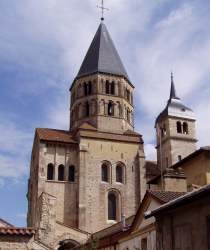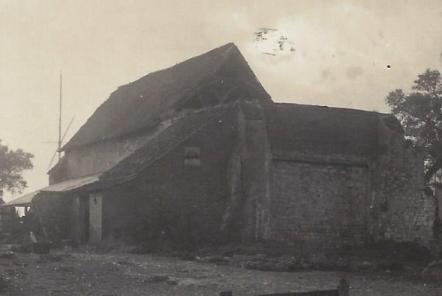Stansgate Priory
Founded before 1121 by Radulf Filius Brientii as a Cluniac Priory
The Cluniacs has a stricter rule and more centralised discipline than the widespread Benedictines.
They emphasised the severity of the monastic code as to fasting and silence and laid stress on liturgical splendour.
Although never becoming a great power in England, this sect spread throughout Europe from its base at Cluny Abbey in France.
The order maintained a hierarchical order with Lewes Priory regarded as being the most important and the Essex Priories at Prittlewell, Horkesley and Stansgate all subservient to Lewes.
 Cluny Abbey in France
Cluny Abbey in France
The Priory never established itself as a powerhouse having a Prior and a few monk whose duties included looking after livestock.
In 1303 the Priory was so poor that the Prior successfully petitioned for the annual treasury charge of £4 a year be waived as the living at the priory was barely sufficient for the Abbot and the Monks.
By 1324 an inventory of the Priory showed the live stock consisted of a palfrey of the prior valued at 20s., six stots worth 30s., three oxen worth 30s. and a boar, two sows, eight pigs and ten piglets, worth together 22s. 6d. The list of goods included such articles as two chalices, two copes, four sets of vestments, two missals, etc., and also two cups of 'maser,' four silver spoons, three brazen pots.
An example of this was Prior William of Prittlewell who upset the Prior of Lewes and so in 1320, some monks came in force and wounded Prior William while he was celebrating mass at the altar, and dragged him and three of his monks off to Lewes, bound hand and foot At the death of William (probably from the wound) the dispute ended.
The Abbey was dedicated to St Mary Magdalen and served as parish church for Steeple until its closure on 9 February 1525 . At the time of closure the Priory had a prior and just 2 monks.

Coat of arms of Cluniac Monasteries
Stansgate fell victim to international politics between the King and the Roman Catholic Church fanned by public resentment about the behaviour of the Monks many of whom seemed to care more about a good life than about religion. In 1524 Cardinal Wolseley obtained a papal bull closing a number of religious houses including Stansgate and then persuaded King Henry VII to use the money raised by closure to found Christchurch College at Oxford.
The remains of the Priory were used as a barn in a similar fate to that of nearby St Peters Chapel.
The Priory retained a special aura with local residents as evidenced by the local legend below .
A farmer was ploughing the field next to
the old Priory when he spoke out loud that the Devil could have his
soul if he would do the ploughing. The Devil then appeared and took
the plough. The frightened farmer ran to the priory church with the
devil in hot pursuit. As the farmer entered the church the devil
made a lunge just missing the farmer.
According to legend marks could be seen on the stone building
that were reputed to be the devil.
The field in question was not again ploughed until 1946 as
successive farmers were worried by the legend.

The last remains pictured above were finally destroyed in 1922.
The building was a plain rectangle with a transept on the north side and a chancel or apse on the east. The monks living area was to the south of the church.
The site of the Abbey is privately owned forming part of the land farmed by Stansgate Abbey Farm. The land is private property with no direct public access.
The site is often asociated with the Labour Party politicians Viscount Stansgate (Anthony Wedgewood-Benn) and Hilary Benn, their Grandfather John Williams Benn and their father William Wedgewood Benn who took the name Stansgate when he was appointed to the House of Lords in 1942 following a distinguished political and military career. In about 1900 the family moved into Stansgate House which was built on land that had formed part of Stansgate Abbey farm.
Click here for a list of Priors of Stansgate Priory.

